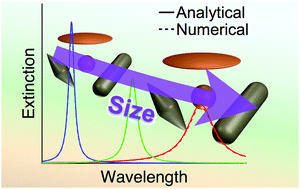当前位置:
X-MOL 学术
›
Chem. Soc. Rev.
›
论文详情
Our official English website, www.x-mol.net, welcomes your feedback! (Note: you will need to create a separate account there.)
Universal analytical modeling of plasmonic nanoparticles
Chemical Society Reviews ( IF 46.2 ) Pub Date : 2017-09-20 00:00:00 , DOI: 10.1039/c6cs00919k Renwen Yu 1, 2, 3, 4 , Luis M. Liz-Marzán 4, 5, 6, 7, 8 , F. Javier García de Abajo 1, 2, 3, 4, 9
Chemical Society Reviews ( IF 46.2 ) Pub Date : 2017-09-20 00:00:00 , DOI: 10.1039/c6cs00919k Renwen Yu 1, 2, 3, 4 , Luis M. Liz-Marzán 4, 5, 6, 7, 8 , F. Javier García de Abajo 1, 2, 3, 4, 9
Affiliation

|
Control over the optical response of metal nanoparticles and their associated plasmons is currently enabling many promising applications in areas as diverse as biosensing and photocatalysis. In this context, experiments based upon colloid synthesis and nanofabricated structures are assisted by numerical electromagnetic modeling, which supplies predictive simulations, but not the kind of physical intuition needed for exploration of new ideas, such as one finds when simple mathematical expressions can describe a problem. This tutorial review presents and extends a simple analytical simulation method that allows us to accurately describe the optical response of metal nanoparticles, including retardation effects, without the requirement of large computational resources. More precisely, plasmonic extinction spectra and near-field enhancement are described through a small set of real numbers for each nanoparticle shape, which we tabulate for a wide selection of common morphologies. Remarkably, these numbers are independent of size, composition and environment. We further present a compilation of nanoplasmonic experimental data that are excellently described by the simple mathematical expressions here introduced.
中文翻译:

等离子体纳米粒子的通用分析建模
目前,控制金属纳米粒子及其相关等离激元的光学响应使得在生物传感和光催化等领域具有许多广阔的应用前景。在这种情况下,基于胶体合成和纳米结构的实验得到了数值电磁模型的辅助,该模型提供了预测性模拟,但并没有探索新思想所需的那种物理直觉,例如人们发现简单的数学表达式可以描述一个问题时。本教程复习提出并扩展了一种简单的分析模拟方法,该方法允许我们准确描述金属纳米粒子的光学响应,包括延迟效应,而无需大量的计算资源。更准确地说,通过对每个纳米粒子形状的一小组实数来描述等离子体消光光谱和近场增强,我们将其列表化为多种常见形态。值得注意的是,这些数字与大小,组成和环境无关。我们进一步提出了纳米等离子体实验数据的汇编,通过此处介绍的简单数学表达式可以很好地描述纳米等离子体实验数据。
更新日期:2017-11-13
中文翻译:

等离子体纳米粒子的通用分析建模
目前,控制金属纳米粒子及其相关等离激元的光学响应使得在生物传感和光催化等领域具有许多广阔的应用前景。在这种情况下,基于胶体合成和纳米结构的实验得到了数值电磁模型的辅助,该模型提供了预测性模拟,但并没有探索新思想所需的那种物理直觉,例如人们发现简单的数学表达式可以描述一个问题时。本教程复习提出并扩展了一种简单的分析模拟方法,该方法允许我们准确描述金属纳米粒子的光学响应,包括延迟效应,而无需大量的计算资源。更准确地说,通过对每个纳米粒子形状的一小组实数来描述等离子体消光光谱和近场增强,我们将其列表化为多种常见形态。值得注意的是,这些数字与大小,组成和环境无关。我们进一步提出了纳米等离子体实验数据的汇编,通过此处介绍的简单数学表达式可以很好地描述纳米等离子体实验数据。



























 京公网安备 11010802027423号
京公网安备 11010802027423号